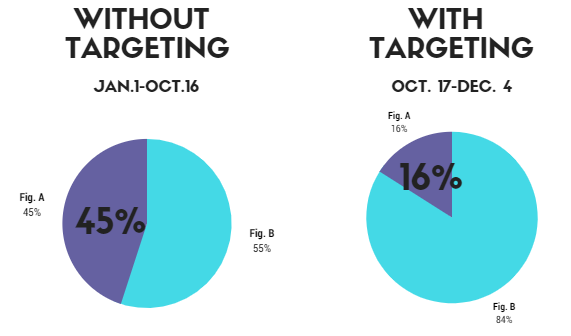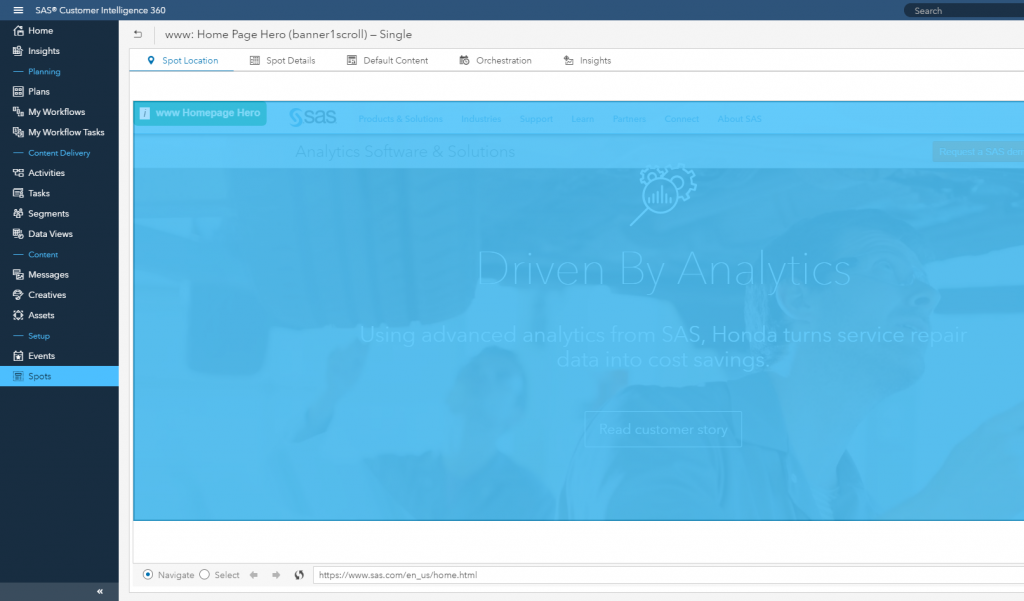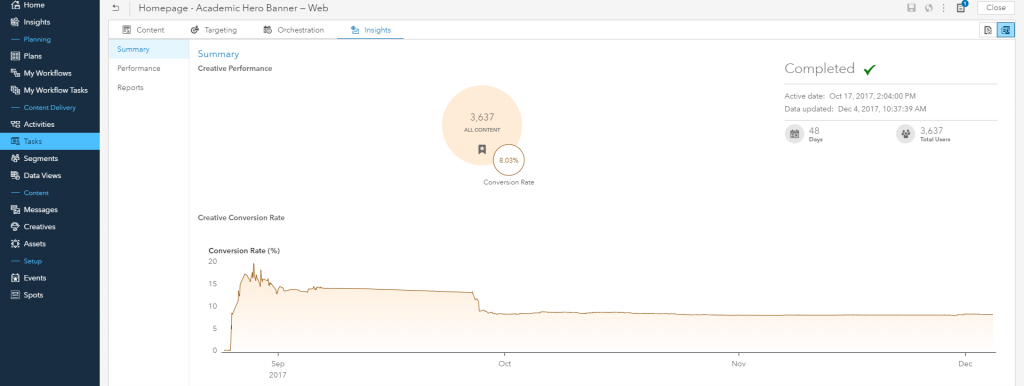Author's note: A special thanks to Mark Korey and Laura Maroglou who generously provided their expertise in creating the use case for this post.
On any given month, several million visitors come to the SAS web – whether it’s www.sas.com, support.sas.com, blogs.sas.com or communities.sas.com. The one thing that these millions of visitors have in common is that they came to the SAS web with a task. Those tasks are varied, but they’re all looking to accomplish something.
They might be an existing customer who’s interested in learning “how-to” around a particular product, so they’re looking for tutorial and documentation content. They might be a prospect researching to see if SAS has solutions and products that can help solve a particular business problem for their industry. Or, maybe they’re a student or a professor who is looking for SAS academic software options so they can learn SAS. These visitors, their needs and the organizations they come from vary, but what doesn’t change is the obligation and opportunity to provide the most optimal web experiences possible for our end users.
looking for tutorial and documentation content. They might be a prospect researching to see if SAS has solutions and products that can help solve a particular business problem for their industry. Or, maybe they’re a student or a professor who is looking for SAS academic software options so they can learn SAS. These visitors, their needs and the organizations they come from vary, but what doesn’t change is the obligation and opportunity to provide the most optimal web experiences possible for our end users.
That's where the power of web optimization comes into play - the ability and focus on not just building great initial web experiences, but rather the ability and focus to the learn from those web experiences, determine what's good, bad or ineffective and what can be improved.
A focus on understanding what is performing well on your website, and continual improvement is a must-have because the world we live in is a world where digital reality is reality for many of us, and the business impact of a poor web user experience is something that companies can never afford. It has direct impact to potential lead generation opportunities, customer retention and brand impact – all things that heavily rely on first-rate web experiences.
At SAS, we have two powerful focus areas when it comes to the web optimization process as I’ll explain below.
Know with data: Understand your web visitor
The foundation for building and optimizing any experience is to understand your user. In the digital world, a plethora of data may be collected and analyzed to enhance customer profiles. The web user experience team behind sas.com achieves this using SAS Customer Intelligence 360.
Every hour of every day thousands of people around the world visit sas.com. How do you meet the needs of each person efficiently? A one-size-fits-all approach doesn’t work.
It starts with data.
It starts with collecting website visitor behavior data, analyzing it, finding meaningful segments, and ultimately building models that identify personas on the website (e.g., prospects, SAS users, students, etc.).
Data collection
SAS Customer Intelligence 360 collects every page view from every visitor. All you need to do is place one JavaScript tag on your site with your favorite tag manager and you’re up and running. SAS Customer Intelligence 360 begins collecting site visitors and their behavior in a cloud-based data hub. Each visitor receives a unique cookie. This cookie allows all future sessions to be linked back to the same visitor. At SAS, we use the same JavaScript tag across all our web sites – www.sas.com, support.sas.com, blogs.sas.com, etc., as well as subsidiaries such as www.jmp.com and microsites such as www.confidencequotient.com. This provides a centralized holistic view of an individual’s journey across all sas.com properties over time.
Then, we define which website events and goals yield metrics that matter. Registering for a webinar, downloading SAS University Edition, creating a SAS Profile, contributing to SAS communities or submitting a Contact Us form are some activities we track that help us understand who someone is and why they are on sas.com.
Every new site visitor is anonymous. SAS Customer Intelligence 360 uses attributes about the visitor’s referring source (e.g. organic search, ad banner, etc.), browser (e.g., tablet, phone or computer), and IP address (e.g., geo location) to immediately collect foundational information. Depending on the IP address, company and industry may also be obtainable. Using this data, we build the foundation.
With the User Identification feature anonymous visitors become known. SAS Customer Intelligence 360 is able to identify an individual user by email address. When an email address is entered on www.sas.com to log on to a SAS profile, register for a white paper registration, subscribe to a newsletter, or anywhere a user enters their email address, we identify that person as an individual. When user is known, visits across devices are linked to the same person and off-site data can be added to a person’s profile to enable more advanced segmentation.
Differentiate with targeting: One size doesn’t fit all
Now that we have the proper data collection using SAS Customer Intelligence 360, it’s time to segment and target. We know we have lots of different people performing many different tasks on sas.com. Using SAS Customer Intelligence 360, real-time behavior triggers, offsite data and SIC codes, we are able to offer highly relevant content to our visitors and direct them quickly to the information they seek.
An example of a real use case is the academic visitor segment made up of students and professors. Because supporting learning and education is a core value at SAS, we offer academic users free software to learn SAS, statistics, analytics, etc. As you can imagine, we get a lot of traffic from students - which is great! However, we also get a lot of students asking for our free software from our sales leads system via the home page. Using SAS Customer Intelligence 360, we are able to redirect these visitors to an academic experience - content built just for them - using the targeting functionality built into SAS Customer Intelligence 360. Here’s how we did it.
The business challenge
We knew that 45 percent of our lead forms were filled out by academics wanting to download the SAS University Edition.
Students and professors were filling out lead forms to get the software. As you can guess, having academics in our lead system delays the students from downloading what they need in real-time and creates unnecessary work for sales. With SAS Customer Intelligence 360 targeting, we improved the user experience and business efficiency.
The solution: SAS Customer Intelligence 360
Once we are able to identify the visitor as an academic, we provide an academic-specific hero image on the sas.com home page, then direct them to the academics pages where they can download SAS University Edition.
SAS Customer Intelligence 360 enables us to identify students and professors using an education SIC code and an .edu referring domain.
Was it successful? Yes, in fact that 45 percent of academics completing lead forms dropped to 16 percent after applying our targeting efforts on just one page.
Here’s how you can do it
First, choose the spot you’re going to target. In the figure below, we chose the area in light blue.
Then, set up the creative element you want to use. The example below is an image of an academic setting.
Next, build the task and targeting segment set up. Using the SIC Code Directory, we targeted academic institutions. As a result, anyone visiting this page from a university campus sees the “Academics” hero. Then we targeted referring educational domains – those ending in .edu.
Once it’s live, assess page performance. For this targeting experience, we saw more than an 8 percent click-through rate on our targeted hero promotion and content. Generally, we see between around a 2-3 percent click-through rate for non-targeted hero promotion. Looking at this performance data, we know that by getting in front of segmented visitors with more relevant messaging at the right time absolutely can help provide better visitor engagement and action.
This is just one example of how we use data collection, visitor segmentation and content targeting to optimize and improve the SAS web experience. We have dozens of other scenarios, for other types of visitors, where the same approach is taken for delivering the most relevant experiences. Your organization’s digital web experience matters, a lot. For your brand, for customer experience and retention, for lead generation. A poor experience has broad, long-term ramifications for how users will perceive an organization’s brand and quality. A need to focus on always improving the web user experience through optimization, testing and targeting is a must-have in an ever-growing digital world.






